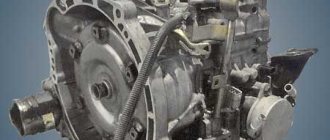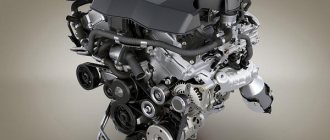4943 Apr 20
Motors are the main reason for the pride of Toyota car owners. If you pay attention to modern engine building, you will notice that all manufacturers have a tendency to make unreliable turbocharged engines with small volumes. This is done to comply with new environmental regulations.
Toyota took a different path, deciding to continue producing reliable naturally aspirated engines with large volumes.
Their environmental standards are achieved through a number of modifications to the gas distribution system, the presence of additional injectors in the intake manifold, as well as dual-mode operation.
Two-liter unit 6AR-FSE
Over the years, all generations of Camry have been equipped with time-tested 1AZ-FE engines, which were only further refined, but the overall design was the same. They were incredibly reliable: their service life reached 500 thousand kilometers. For the Camry XV50 model they were thoroughly redesigned.
The engine, having the same volume, has become 13 percent more economical and 17 percent faster. The upgraded version accelerates the car a full two seconds faster than its predecessors. Such high technology affected the resource, which became smaller. This does not mean that the engine has become unreliable, it’s just that now its service life is 350 thousand kilometers, which is very good compared to modern engines, which can operate without breakdowns for half as long.
A huge advantage of the 6AR-FSE is the timing chain drive, which can operate without problems for 200 thousand kilometers.
Notes to the driver
Naturally, the actual gasoline consumption of a Toyota Camry will differ from the data provided by the manufacturer, depending on the influencing external and internal factors.
The type of gearbox also plays an important role, because with a manual gearbox the fuel consumption of the car is reduced.
Do not forget to carry out a routine inspection of your car and carefully check the fuel filter if you do not want your gasoline consumption to differ significantly from the permissible norm. There are more positive reviews about this car brand than negative ones.
Combined injection system
The new engine operates in two different modes at idle and when driving. This reduces CO2 emissions and saves fuel. At idle speed, the unit operates according to the Atkinson cycle, the essence of which is a lower compression ratio and less fuel supply. As soon as the motor is driven, it switches to normal operation.
In normal mode, the car operates with a high compression ratio, almost the same as that of sports units. Mazda has a similar technology called Skyactive. But if Mazda’s high-tech engine is designed for 98-octane gasoline, then Toyota’s is designed for 92-octane gasoline.
It is recommended to change engine oil for 6AR-FSE every 10 thousand kilometers.
Recommended oils: 0W30 and 5W30, tank size - 5 liters.
This is the most popular engine in the Camry model, and most Camrys come with it.
The main characteristics of the motor are shown in the table below.
| Name | Power/ torque | Displacement | Quantity cylinders/ valves | Acceleration/consumption | Timing drive | Recommended fuel/oil |
| 6 AR-FSE | 150/199 | 2.0 | 4/16 | 10.2/7.2 | Chain | AI-95/5W30, 0W30 |
Two liters and a CVT: getting to know the updated Toyota Camry
Several “Car of the Year” awards, prizes from famous magazines, a segment leader in maintaining residual value, the best-selling model among competitors and a bunch of other titles, cups and certificates that you can put on a shelf in your office and be proud of. All this about the Toyota Camry - the favorite of middle managers, taxi companies and officials.
The current, eighth, generation of the sedan appeared in 2021: then the car moved to TNGA architecture, changed its appearance and received a new 3.5 engine. Now the model has undergone an update, and not only has its appearance been corrected, but the range of power plants has also been shaken up. Does this make the Camry any better? Let's check it now.
Let's start with the appearance...
Traditionally, automakers, whose products are already selling well, during restyling act on the principle “why change what works well” (the only exception is the recent update of the Hyundai Santa Fe crossover, which, in fact, has become a completely different car).
|
|
So Toyota decided not to show off. Are most clients satisfied with the appearance of the sedan? Okay, let's change the front bumper and the side design of the radiator grill a little, which can now be silver, chrome or black. Have customers come to dealers and asked to repaint the grille black? Okay, now this design can be ordered directly from the factory by selecting the appropriate configuration. And to make it not completely boring, you can also add a new design of 17- and 18-inch wheels.
This is what the GR Sport version looks like. This metallic red is a new color in the line. Additional payment for two-color design - 35 thousand rubles.
An important addition to the line is the appearance of a special version of the GR Sport, prepared by Toyota's Gazoo Racing division, which builds sports and racing cars.
Toyota Camry GR Sport
Toyota Camry GR Sport
Toyota Camry GR Sport
Toyota Camry GR Sport
Toyota Camry GR Sport
Toyota Camry GR Sport
Toyota Camry GR Sport
Toyota Camry GR Sport
The differences between this modification and the regular Camry are a two-tone body paint (red or white with a black roof), black rear-view mirror housings, a spoiler on the edge of the trunk, black moldings on the doors, transparent lights (though only for cars with a 3.5 engine), special rims and, of course, GR Sport nameplates. In red it really looks spectacular, and attracts attention no worse than lingerie models suddenly appearing on a crowded street.
The owner of such a red and black Camry is guaranteed increased attention from others. Verified.
Toyota Camry GR Sport
Toyota Camry GR Sport
Toyota Camry GR Sport
Toyota Camry GR Sport
There are also changes in interior design. The interior will feature red stitching on the seats, steering wheel, center armrest and front panel, special decorative inserts, an engine start button with the inscription GR Sport and - an exclusive feature - a drive mode selector (Eco/Normal/Sport). It changes the settings of the engine, gearbox, response to pressing the gas pedal and is available only for top-end cars with a 3.5-liter engine. Unfortunately, it was not possible to drive such a car and check how it all works.
Toyota Camry GR Sport
Toyota Camry GR Sport
Toyota Camry GR Sport
Toyota Camry GR Sport
Toyota Camry GR Sport
Toyota Camry GR Sport
Well, since we're talking about the interior...
The most noticeable (and most important) change in the cabin is the new multimedia system. Now there is the same tablet as in the Toyota RAV4. The screen diagonal has increased by one inch to nine inches, there is navigation, as well as support for Apple CarPlay and Android Auto.
The multimedia complex supports Apple CarPlay and Android Auto. There are no questions about performance. The only pity is that the interface design has not yet changed
With the advent of another multimedia complex, the location of the air ducts of the ventilation system had to be changed. But all other interior elements remained the same and in their places.
Among the minor improvements are new decorative dies on the front panel, including a “dark wood” option. And that’s all, actually.
How? Is that all?
Of course not. We left the most interesting thing - the new power plants - for dessert.
Starting with the pre-top version of Luxury Safety, Camry will receive a system that allows you to control the car remotely. For example, you can determine its location, monitor the battery charge, plan a trip route, or sign up the car for service.
Toyota changed two of the three engines – only the top-end 3.5 “six” remained untouched. The previous base unit has been replaced by a new two-liter “four”, which is now paired not with a six-speed automatic, but with a “cunning” CVT equipped with a mechanical starting gear. In fact, it's the same powertrain that powers the RAV4 (you can read more about it in our crossover test). It differs from the previous version by a gas distribution system on the intake valves, combined injection, an increased compression ratio (13:1) and the presence of front hydraulic mounts to reduce vibrations.
The power of the two-liter engine remained the same as before the restyling (150 horsepower), but the maximum torque increased by 12 Nm (to 206 Nm), and its shelf expanded (instead of 4700 it is now available in the range of 4400–4900 rpm). The company promises that the Camry with this unit will become a little more dynamic and more economical: the updated sedan accelerates to “hundreds” one and a half seconds faster, and consumption in the combined cycle will decrease by almost a liter - to six liters per hundred kilometers.
We had the opportunity to compare the updated two-liter Camry with its predecessor and the conclusion is this: despite not the most impressive numbers on paper, in reality this car works! Toyota arranged for us to drag race between the old and new car on the airfield runway, and each race showed the same result - the restyled sedan pulled away from the old car almost immediately by a length and a half and continued to pull away. In addition, the Camry felt faster when accelerating from 60 and 80 kilometers per hour.
The complex of safety systems has added adaptive cruise control, working in conjunction with a traffic sign reading system (it recognizes restrictions and prompts the driver to reduce the speed to the recommended), functions for keeping the car in the center of the lane, reducing speed in turns, assistance when turning at an intersection (helps to avoid accident when turning left).
In everyday driving you are unlikely to feel a lack of power (unless, of course, you switched to this car from a six-cylinder modification). That's certainly true in the city. The car drives briskly: during a kickdown, the tachometer needle instantly jumps to about 4500 rpm and the engine continues to spin up to the cutoff. At the same time, the variator simulates changing “virtual” gears, preventing the engine from howling at high speeds. In general, there are no complaints at all about the settings of the continuously variable transmission - a very harmonious pair.
The CVT's first mechanical starting gear helps protect the transmission from shock loads, such as when slipping or quickly starting from a standstill.
Even on the highway, a two-liter sedan can drive quite actively, almost keeping up with a car with a 2.5 engine. And, perhaps, the only case when the driver of a basic Camry may wish for a more powerful engine is when overtaking long convoys on highways.
According to data for the first three months of 2021, 79 percent of Camry buyers choose the version with the 2.5 engine. The two-litre cars account for just eight per cent of sales, while the top-end variant accounts for 13 per cent.
The 2.5 engine is also new. It has become more powerful (200 horsepower instead of 181) and more economical (combined cycle consumption is 6.8 liters instead of 8.3 liters), while allowing the car to hit “hundreds” almost a second faster than its predecessor - in 8.7 seconds. And - an important addition - the engine is now coupled not with a six-speed, but with an eight-speed Aisin automatic. Moreover, this transmission differs from the one installed on the Camry with a six-cylinder engine.
Corporate sales (government and commercial companies, taxis, leasing and individual entrepreneurs) account for about 46 percent of Camry sales. The rest is from private buyers.
In drag, the difference between the updated and pre-restyling cars is not as noticeable as in the case of the two-liter version. The new car begins to take the lead somewhere after 60-70 kilometers per hour by half a body length - it cannot break away much from its predecessor.
The new gearbox changes gears quickly and works logically, although it tries to get into higher gears at every opportunity to save fuel. The transition to kick-down is accompanied by a slight hitch, but in all other cases this machine can only be praised.
The chassis and steering settings have not changed. The Camry still handles very well - reactions are quick and accurate. The suspension is quite comfortable - it handles most unevenness perfectly, and only dislikes very large potholes.
And how much does it cost now?
Naturally, cars have become more expensive, but not very much. The cost of the basic version increased by 29.5 thousand - up to 1,880,500 rubles. Prices for cars with a 2.5 engine have risen by 87 thousand - at least 2,151,500 rubles.
The GR Sport version is available only for sedans with 2.5 and 3.5 engines - 2,405,500 and 2,703,500 rubles, respectively. The most expensive car costs 2,916,500 rubles - 58 thousand rubles more expensive.
In general, the restyling was a success. The cars were refreshed in appearance, new multimedia was added, they were made a little faster and more economical, without spoiling the important characteristics for which these cars were purchased. So, apparently, new prizes and certificates are just around the corner - Camry will definitely not fall out of love for a long time. /m
| Car | Toyota Camry |
| Like | The two-liter Camry now drives well |
| I do not like | The image of the model in Russia is so-so |
| Verdict | Technical changes have definitely benefited Toyota Camry |
| Engine | 2487³, L4, 200 hp, 243 Nm |
| Transmission | AKP-8 |
| Numbers | 0–100 km/h — 8.7 s, 210 km/h |
| Weight | 1555 kg |
Detailed technical specifications of Toyota Camry
| 2.0 | 2.5 | 3.5 | |
| engine's type | petrol, I4 | petrol, I4 | petrol, V6 |
| Working volume, cm³ | 1987 | 2487 | 3456 |
| Max. power, hp | 150 | 200 | 249 |
| Max. torque, Nm/rpm | 206/4400–4900 | 243/4000–5000 | 356/4600–4700 |
| type of drive | front | front | front |
| Transmission | variable speed drive | automatic, 8-speed | automatic, 8-speed |
| Front suspension | spring, McPherson | spring, McPherson | spring, McPherson |
| Rear suspension | spring, multi-link | spring, multi-link | spring, multi-link |
| Dimensions (LxWxH), mm | 4885x1840x1455 | 4885x1840x1455 | 4885x1840x1455 |
| Wheelbase, mm | 2825 | 2825 | 2825 |
| Trunk volume, l | 524 | 524 | 524 |
| Ground clearance, mm | 155 | 155 | 155 |
| Curb weight, kg | 1560 | 1555 | 1680 |
| Total weight, kg | 2030 | 2030 | 2030 |
| Acceleration 0–100 km/h, s | 9,5 | 8,7 | 7,7 |
| Max. speed, km/h | 210 | 210 | 220 |
| Fuel consumption (combined), l/100 km | 6,0 | 6,8 | 8,7 |
| Fuel tank volume, l | 60 | 60 | 60 |
| price, rub. | from 1 880 500 | from 2,151,000 | 2 703 000 |











